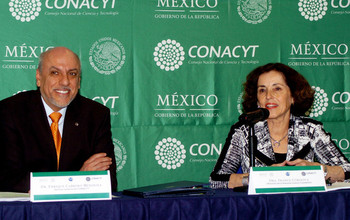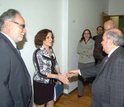News Release 15-022
National Science Foundation director visits Mexico to strengthen and promote scientific and technological collaboration
Visit includes discussions with Mexico's CONACYT and participation in the inauguration of the High Altitude Water Cherenkov (HAWC) observatory

NSF Director France Cordova holds a press conference with Enrique Cabrera Mendoza of CONACYT.
March 18, 2015
This material is available primarily for archival purposes. Telephone numbers or other contact information may be out of date; please see current contact information at media contacts.
National Science Foundation (NSF) Director France A. Córdova is visiting Mexico this week to strengthen and promote scientific and technological collaboration. She will meet with Enrique Cabrero Mendoza, director general of the Consejo Nacional de Ciencia y Tecnología (CONACYT) to discuss joint projects in science, technology, education and innovation.
"The unique partnership between the U.S. and Mexico allows us to leverage our strengths and resources to address similar goals," Córdova said. "Both the U.S. and Mexico wish to better understand the food, energy, water nexus, and how to translate the results from scientific discoveries more quickly to the market place. With large numbers of multinational companies with operations both in the U.S. and Mexico, we also have a strong interest in robust industry-university cooperative research. In addition, both countries wish to attract more youth to become scientists and engineers."
Córdova and Cabrero will inaugurate the High Altitude Water Cherenkov (HAWC) observatory near Puebla, Mexico. HAWC, which is also funded by the Department of Energy, will help scientists better understand black holes, supernovae and the origins of the universe. HAWC has unique capabilities for detecting the highest-energy electromagnetic radiation, and complements other gamma ray observatories around the world.
Other collaborations include CONACYT's participation in NSF's Partnerships for International Research and Education program (PIRE). PIRE supports high-quality projects where advances in research and education could not occur without international engagements. Mexico joins 10 other countries on the PIRE solicitation, the only country from the Americas.
CONACYT is also a new partner in NSF's Graduate Research Opportunities Worldwide (GROW) program, which allows U.S. students a chance to participate in academic exchanges for research collaborations in other countries. Mexico will welcome its first American students in 2016.
As part of the visit, CONACYT and NSF will discuss expanding a model of NSF's existing I-Corps program across Mexico. NSF created I-Corps to enable researchers to identify product opportunities and commercialize them by creating technology enterprises. Mexico hopes to adopt the I-Corps pilot program to support its university researchers to do the same. This is the first time the I-Corps curriculum has been taught outside the United States. This collaboration also involves the U.S. Department of State, its embassy in Mexico and the U.S.-Mexico Foundation for Science (FUMEC).
In addition, NSF and CONACYT are discussing how to strengthen public-private partnerships between the two countries through NSF's Industry University Collaborative Research Centers program (I/UCRC). This program develops long-term partnerships among industry, academia and government through centers of research. Currently, four NSF centers partner with Mexican institutions in advanced nonferrous alloys, intelligent manufacturing, logistics/distribution and petroleum. Expanding these partnerships will contribute to Mexico's research infrastructure and its science and engineering workforce.
-NSF-
-
Córdova is meeting with university and government leaders during her visit.
Credit and Larger Version
Media Contacts
Maria C. Zacharias, NSF, (703) 292-8454, email: mzachari@nsf.gov
The U.S. National Science Foundation propels the nation forward by advancing fundamental research in all fields of science and engineering. NSF supports research and people by providing facilities, instruments and funding to support their ingenuity and sustain the U.S. as a global leader in research and innovation. With a fiscal year 2023 budget of $9.5 billion, NSF funds reach all 50 states through grants to nearly 2,000 colleges, universities and institutions. Each year, NSF receives more than 40,000 competitive proposals and makes about 11,000 new awards. Those awards include support for cooperative research with industry, Arctic and Antarctic research and operations, and U.S. participation in international scientific efforts.
Connect with us online
NSF website: nsf.gov
NSF News: nsf.gov/news
For News Media: nsf.gov/news/newsroom
Statistics: nsf.gov/statistics/
Awards database: nsf.gov/awardsearch/
Follow us on social
Twitter: twitter.com/NSF
Facebook: facebook.com/US.NSF
Instagram: instagram.com/nsfgov



